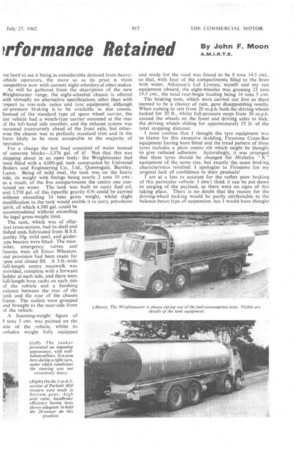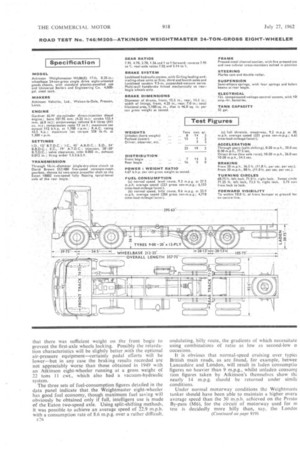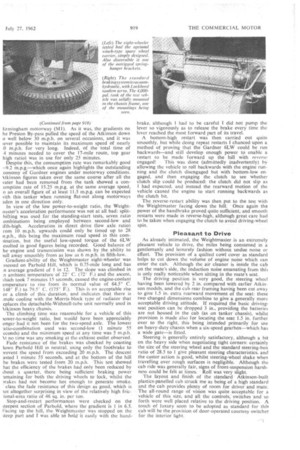Weight a
Page 64

Page 65

Page 66

Page 71

If you've noticed an error in this article please click here to report it so we can fix it.
Prformance Retained
By John F. Moon
A.M.I.R.T.E.
BECAUSE of the current—and in many ways commendable—trend to increase vehicle power-to-weight ratios, and with them performance, heavy-duty maximum-capacity chassis have been growing in terms of unladen weight. Some operators, in turn, have been jibbing. at this increased unprofitable weight, and have been looking for lighter designs, as a result of which several unconventional types have been produced—albeit in small quantities. Atkinson Vehicles, Ltd., have arrested this trend, however, with the introduction of their new Weightmaster range, for the eight-wheeled model in this range has a chassis-cab weight virtually as light as that of anything else of the same gross-weight rating so far produced in Great Britainirrespeotive of the type of povier unit. A payload crf 17.5 tons is feasible, in fact, with a light platform body.
HOw this has been achieved is explained on the preceding two pages, but this new eight-wheeler—the chassis-cab weight of which is only 5 tons 15 cwt.—has a road performance. up to the currently acceptable standard, the low powerto-weight ratio given by its Gardner 6LW diesel engine .being,compensated for by the use of a five-speed gearbox And Eaton two-speedaxle.'. This combination gives a top speed approaching 40. m.p.h., and a gradient-ability which permits easy _restarts in bottom gear, high ratio, on a .1-in-6.5 gradient, the bottom-low potential being in the
region of 1 in 5.5. . .
Admittedly, the cold-blooded acceleration performance is not remarkable in terms of figures alone, but the Weightmaster eight-wheeler can hold its own with most of the other heavy vehicles on British roads and its overall fuel c24 economy is a most attractive consideration—particult in view of its increased payload potential.
Added to these advantages are the usual high standarc assembly for which Atkinson vehicles are renowned and sort of driving conditions which make Atkinsons the ei of less fortunate drivers: indeed, this new Atkinson such a pleasiire to handle—despite its comparatively power—that I spent almost all of two days in the driv seat, and enjoyed every minute of it. Let's face it, i vehicle can keep its driver happy, that driver is more lit to do a full and conscientious day's work than the man v has to fight with his lorry every inch of the route.
At any rate, I was more than pleased with the ove picture of the Atkinson Weightmaster eight-wheeler. I
lot hard to see it being in considerable demand from heavyiehicle operators, the more so as its price is more :orimetitive now with current eight-wheelers of other makes.
As will be gathered from the description of the new Weightmaster range, the eight-wheeled chassis is offered with virtually no alternative specifications other than with -espect to rear-axle ratios and tyre equipment, although sir-pressure braking is to be available in due course. Instead of the standard type of spare wheel carrier, the test vehicle had a winch-type carrier mounted at the rear Df the left-hand side member, and the exhaust system was mounted transversely ahead of the front axle, but otherwise the chassis was in perfectly standard trim and in the form likely to be most acceptable to the majority of operators.
. For a change the test load consisted of water instead of concrete blocks-3,376 gal. of .it! Not that this was slopping about in an open body: the Weightmaster had been fitted with a 4,000-gat. tank constructed by Universal Boilers and Engineering Co., Ltd., Queensgate; Burnley, Lancs. Being of mild steel, . the tank was on the heavy side,. its weight with fittings being nearly 2 tons 10 cwt.: as a result, of the five compartments the centre one contained no water. The tank was built to carry fuel. -oil, and 3.750 gal. of this (specific gravity 0.9) .could be Carried without exceeding 24 torts gross weight, whilst. slight modification to the tank Would enable it to carry petroleum spirit, of which 4,380 gal. could be iecommodated without. exceeding he legal gross-weight
The tank, which was of
cross-section, had its shell and fished ends fabricated from B.S.S. ivality 10g. mild steel, and girderype bearers were fitted. The manroles, emergency valves and faucets were all Emco Wheaton, Ind provision had been made for Dpen and closed fill. A 3-ft.-wide full-length centre manwaik
provided, complete with a forward ladder at each side, and there were full-length hose racks on each side A the vehicle and a finishing valance between the rear of the tank and the rear of the chassis frame. The outlets were grouped 3.nd brought to the near-side front of the vehicle.
A licensing-weight figure of 3 tons 5 cwt. was painted on the side of the ,vehicle, whilst its unladen weight fully equipped and ready for the road was found to be 8 tons 14.5 cwt., so that, with four of the compartments filled to the brim with water. Atkinson's Lol Livesey, myself and my test equipment aboard, the eight-wheeler was grossing 23 tons 19.5 cwt., the total rear-bogie loading being 16 tons 5 cwt.
The braking tests, which were carried out first as there seemed to be a chance of rain, gave disaPpointing. results. When coming to rest from 20 m.p.h. both the driving wheels locked for 20 ft., whilst full-pressure stops from 30 m.p.h. caused the wheels on the front and driving axles to lock, the driving wheels sliding for approximately 55 ft. of the total stopping distance.
I must confess that I thought the tyre equipment was to blame for this excessive skidding, Firestone Cross-Bar equipment having been fitted and the tread pattern of these tyres includes a plain centre rib which might be thought to give reduced adhesion. Accordingly,, it was arranged that these tyres should be changed for Michelin " X equipment of the same size, but exactly the same braking characteristics resulted: I apologize to Firestone for my original lack of confidence in their products!
I am at a loss to account for the rather poor braking of this particular vehicle: I don't think it can be put down to surging of the payload, as there were no signs of this taking place. There is no doubt that the reason for the driving-wheel locking would be partty attributable to the balance-beam type of suspension, but I vvould have thought that there was sufficient weight on the front bogie to prevent the first-axle wheels locking. Possibly the retardation characteristics will be slightly better with the optional air-pressure equipment-certainly pedal efforts will be lower-but in any case the braking results recorded are not appreciably worse than those obtained in 1949 with an Atkinson eight-wheeler running at a gross weight of 22 tons 11 cwt., which also had a vacuum-hydraulic system.
The three sets of fuel-consumption figures detailed in the data panel indicate that the Weightmaster eight-wheeler has good fuel economy, though maximum fuel saving will obviously be obtained only if full, intelligent use is made of the Eaton two-speed axle. Using split-shifting methods, it was possible to achieve an average speed of 22.9 m.p.h. with a consumption rate of 8.6 m.p.g. over a rather difficult,
c26 undulating, hilly route, the gradients of which necessitate using combinations of ratio as low as second-low o occasions.
It is obvious that normal-speed cruising over typic British main roads, as are found, for example, betwee Lancashire and London, will result in laden consumptio figures no heavier than 9 m.p.g., whilst unladen consumt tion figures taken by Atkinson's themselves show thz nearly 14 m.p.g. should be returned under simih conditions.
Under normal motorway conditions the Weightmasu tanker should have been able to maintain a higher overa average speed than the 30 m.p.h. achieved on the Presto By-pass (M6), for the circuit of motorway used for m test is decidedly more hilly than, say, the Londol
Iirrningham motorway (M1). As it was, the gradients on he Preston By-pass pulled the speed of the Atkinson down o well below 30 m.p.h. on several occasions, and it was lever possible to maintain its maximum speed of nearly .0 m.p.h. for very long, Indeed, of the total time of minutes needed to coyer the 17-mile route, top gear high ratio) was in use for only 25 minutes. • Despite this, the consumption rate was remarkably good –9.2 m.p.g.—which once again highlights the outstanding conorny of Gardner engines under motorway conditions.
ktkinson figurestaken aver the same course after all the vater had been removed from •the' tank showed a conumption rate of 15.25 m.p.g. at the same average speed, o an overall figure of at least 11.5 m.p.g. can be expected vith this tanker when running flat-out along motorways aden in one direction only.'
In In view of the low power-to-weight ratio, the Weight naster's acceleration performance was not at all bad: splithitting was used. for the standing-start tests, seven ratio ombinations being employed between second-low and 11th-high. Acceleration in direct drive. (low axle ratio) rom 10 m.p.h. upwards could only be timed up to 28 n.p.h., this being the maximum road speed in this corniination, but the useful low-speed torque of the 6LW esulted in good figures-being recorded. Good balance of he-engine and transmission was shown by the ability to away smoothly from as low as 6 m.p.h. in fifth-low..
Gradient-ability of the Weightrnaster eight-wheeler was ssessed on Parbold Hill, which is 0.75-mile long and has .n average gradient of 1 in 12. The slope was climbed in n ambient temperature of 22° C. (72° F.) and the ascent, vhich took 7 minutes 15 seconds, caused the engine-coolant emperature. to rise from its normal value of 64.5° C. 148° F.) to 79.5° C. (175° F.). This is an acceptable rise or a climb of this duration, and indicates that there is .mple cooling with the Morris-block type of radiator that eplaces the detachable-Withnell-tube unit normally used in 4tkinson heavy chassis. •
The climbing time was reasonable for a vehicle of this
iower-to-weight ratio, but would have been appreciably otlgbr had it not been for the two-speed axle. The lowest 'atio-combination used was second-low (1 minute 55 econds). and the minimum speed at any time was 5 m.p.h. kt.no time was any smoking at the exhaust outlet observed.
Fade resistance of the brakes was checked by coasting
lawn Parbold Hill in neutral, using only the footbrake to wevent the speed from exceeding 20 m.p.h. The descent asted 1 minute 55 seconds, and at the bottom 'of the hill he brakes were tested from 20 m.p.h. This test showed hat the efficiency of the brakes had Only been reduced by ibout a quarter, there being sufficient braking power .ernaining for • both the driving wheels to lock, whilst the Irakes had not becomehot enough to generate smoke.
class the fade resistance of this design as good, which is tot altogether surprising in View of the relatively high fric ional-area ratio of 46 sq. in: per ton.
Stop-and-restart performances were checked on the ;teepest section of Parbold, where the gradient is 1 in 6.5. Facing up the hill, the Weightrnaster was stopped on the ;teen part and I was able to hold it easily with the hand
brake, although I had to be careful I did not pump the lever so vigorously as to release the brake every time the lever reached the most forward part of its travel.
A bottom-high restart was then carried out quite smoothly, but while doing repeat restarts I chanced upon a method of proving that the Gardner 6LW could be run backwards—and still develop enough power to enable a restart to be made forward up the hill with reverse
engaged! This was done (admittedly inadvertently) by allowing the vehicle to roll backwards with the engine running and the clutch disengaged but with bottom-low engaged, and then engaging the clutch to see whether clutch slip could be produced: the clutch did not slip as I had expected, and instead the rearward motion of the vehicle caused the engine to start running backwards as the clutch bit.
The reverse-restart ability was then put to the •test with the Weightmaster facing down the hill: Once again the power of the handbrake proved quite sufficient, and smooth restarts were made in reverse-high, although great care had to be taken when engaging the clutch to avoid drivMg-wheel spin.
Pleasant to Drive As already intimated, the Weightmaster.is an extremely pleasant vehicle to drive, -the miles being consumed in a gentlemanly and leisurely fashion without undue noise or effort. The provision of a quilted cowl cover as standard helps to cut down the volume of engine noise which can enter the cab. Although the air cleaner is inside the cab on the mate's side, the induction noise emanating from this is only really noticeable when sitting in the mate's seat.
The driving position is very good, the steering wheel having been lowered by 2 in. compared with earlier Atkinson models, and the cab rear framing having been cut away to give 1.5 in. extra rearward movement of the seat: these two changed dimensions combine to give a generally more acceptable driving attitude. If required the basic drivingseat position can be dropped 3 .in., providing the batteries are not housed in the cab (as on tanker chassis), whilst provision is made also for locating the seat-1.5 in. further over to the right, this being intended primarily for use on heavy-duty chassis when a six-speed gearbox-which has a wide gate—is fitted.
Steering is generally entirely satisfactory, although a bit on the heavy side when negotiating tight corners: certainly the size of the steering wheel and the standard steering-box ratio of 28.5 to I give pleasant steering characteristics, and the castor action is good, whilst steering-wheel shake when travelling over rough surfaces is negligible. Although the cab ride was generally fair, signs of front-suspension harshness could be felt at times. • Roll was very slight.
The layout and finish of. the standard Aticinson-built plastics-panelled cab struck me as being of a high standard and the cab provides plenty of room for driver and Mate. The all-round range of vision was quite acceptable for a vehicle of this size, and all the controls,' switches and so forth were well placed relative to the driving position. A touch of luxury soon to be adopted as standard for thiq cab will be the provision of door-operated courtesy switchet for the interior light.
































































































































